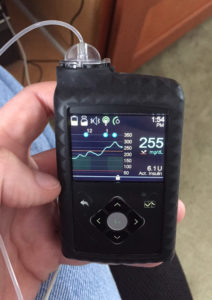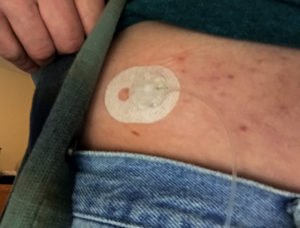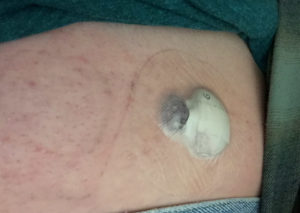Diabetes Upgrade: New Pump and CGM
After several months of back-and-forth with the insurance company, medical supply company, and my doctor’s office, last week I went in to get set up on a new Minimed 670G insulin pump. The thing I’ve been really excited about is that this pump links to a continuous glucose monitor (CGM).
For the past 20 years, I’ve checked my blood sugar by pricking my finger about six times/day and putting a drop of blood onto a test strip. The CGM checks every five minutes, and gives me something close to a real-time graph showing my blood sugar levels and how those levels are changing.
I still need to do the finger-pricks, since the CGM isn’t quite as accurate, and needs to be calibrated. But this means I get much quicker warnings if my sugar starts to go high or low. It also gives me a lot more data to better refine how I take insulin to keep things under control.
Ironically, this came up as I was working on this blog post. I think there was an issue with the site where I plugged the pump into my body, which was causing me to not absorb insulin as well as I should. As a result, my sugar was high. It’s currently 255, to be exact.
Thanks to the CGM, I’d been alerted that it was going high, and had been able to monitor the rise and decide to change the set. Without it, I’d have waited until my next finger-prick.
You can see I’ve already come down a little bit from the peak when I changed my site. Theoretically, that line should keep coming down until it gets into the green-shaded area between the two horizontal red lines.
The only problem so far is that I tend to overreact. It takes time for the body to process insulin or digest and process food. If I take insulin now, I won’t see an immediate effect. Likewise if I eat, say, a chocolate bar, it could be 15 minutes or more before my sugar starts to rise. So if I’m high, I might take a correction dose of insulin. Ten minutes later, I’m still high! What the heck? So the temptation is to take another dose. Unfortunately, “stacking” insulin like this can result in an overcorrection, and suddenly my sugar is too low.
But I’m getting used to it, and I haven’t had any severe problems.
The other inconvenience is I now have not one but two things plugged into my abdomen: the insulin pump site, and the CGM sensor.
Warning: pale belly pics behind the cut.
The pump site is a small (17mm) flexible catheter connected to a tube running to the insulin pump. Pump is delivered through the tube, and life is good. This is much, much better than having to take 5-6 injections every day, which is what I did in my pre-pump days.
You can also see a few red dots from previous sites. Those heal with time, but it means my belly tends to be polka-dotted.
Now I also need to wear a sensor, that looks like so:
The small gray part on the left is the actual sensor. It has a tiny filament that goes into the skin to measure my blood sugar. The larger whitish piece is the transmitter, which relays the sensor readings to my pump. The whole thing is held in place by three layers of thin, flexible tape.
That’s a lot of tape. Far more than I’m used to with the insulin catheter. I discovered that removing said tape, while it’s not as effective as waxing my stomach, still removed about 50% of the hair. So…yeah, I now have a shaved belly.
I go back next week for more training on additional pump features, but so far, I’m really appreciating the CGM. It beeps and buzzes at me a lot more than my old pump, but it should give me better control. And it’s one step closer to becoming a cyborg superhero.









Michael G Phillips
March 7, 2018 @ 3:17 pm
I’m a type 2 diabetic so a pumpand continuous monitor arent indicated but I am very excited about the rf monitors going into testing in europe
Jim C. Hines
March 7, 2018 @ 3:19 pm
rf monitors? I haven’t heard about these…
Michael G Phillips
March 7, 2018 @ 3:22 pm
They aren’t continuous, but dont use lancets or test striips. They beam radio through a narrow bit of skin between thumb and fingers.
Jim C. Hines
March 7, 2018 @ 3:23 pm
Oh cool – I have heard of those. Just didn’t know the name for ’em.
Michael G Phillips
March 7, 2018 @ 3:26 pm
They may have a different name, but that is the tech they use. A cheap radio on a stick so I can test on a whim? Yes
Jesse the K
March 7, 2018 @ 4:13 pm
The tape looks like the same patches used to secure IVs to the back of the hand. I can imagine that also takes its toll on your skin.
Lovely report: assistive tech is my primary fandom.
Lisa Blair
March 7, 2018 @ 11:59 pm
Grats, and I hope it helps with your control. If you get skin peeling or issues from the tape, there is a wipe-on-let-dry barrier film that we use on premature babies in the hospital called cavilon. I had to use it to wear cardiac sensors for a while because of sensitive skin. Looks like an alcohol prep pad. Available otc and works a charm.
Hanneke
March 9, 2018 @ 9:58 am
I had a colleague (now retired) with hard to control diabetes. She was so happy to get the continuous monitor and continuous insulin pump! She wore hers on the outside of her upper arms (one on each arm): less chance of the sensors getting squashed there than on the belly, though you do have to pay attention to not walking into doorjambs and things like that.
She’s convinced it saved her life, when she started going into a hypo in the middle of the night while she was sleeping: the little monitoring box on her nightstand started beeping loudly enough to wake her up to take care of the problem.
I’m happy you have something similar now too.
Pam
March 9, 2018 @ 12:38 pm
I’m thinking of the ‘living in space’ SF, where people may well have tech stuck in their bodies at all times. You’re helping us to get there- one stick at a time.
Jazzlet
March 10, 2018 @ 1:18 pm
I greet my new proto-cyborg overlord!
Cat Eldridge
March 15, 2018 @ 8:12 pm
Interesting. I’m type two, twenty plus years now, but it has taken a low priority for my PCP as I fell backwards down a flight of stairs and kept dying at the ICU. I’m now doing BP after my meds as one of them is intended to control the now nearly seven old continuous headache. It has the tendency to make the BP crash.
Jim, we’ve not reviewed you in a long time. Which should we cover?
Joseph Bender
March 21, 2018 @ 8:01 am
Michael G Phillips,
You might want to ask your Endo about a prescription for a Freestyle Libre monitor. It’s an arm mounted NFC based monitoring system that you scan periodically. It’s not continuous, but is cheaper than CGM and can get approved for Type II patients. The probe insertion process is painless, it just feels like a thwap on the arm.
I just got mine last week and love it, it’s made life a heck of a lot easier for me already. The PC software to download from the meter isn’t terrible either.
Michael G Phillips
March 21, 2018 @ 8:09 am
Oh im happy to use lancets until the rf ones come out. My skin does not respond well to tape or inclusions. I still have scars from the tape they used to secure a hicks line to my chest 8 months ago